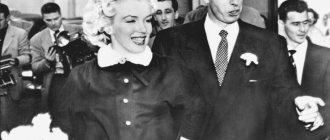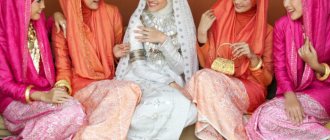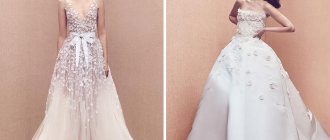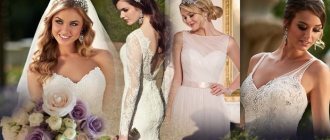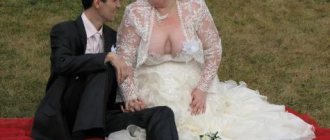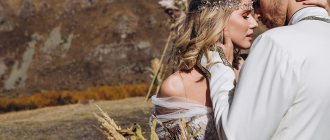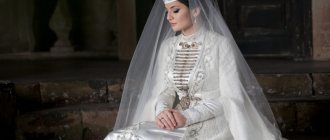Many couples want to make their wedding special, unusual and extraordinary, so they organize a themed celebration. Choosing a Japanese style of celebration guarantees that it will be original and bright. But for this, the bride and groom need to think through everything thoroughly in advance, prepare a lot of accessories, and choose the bride’s outfit according to the theme of the holiday. What types of Japanese wedding dresses are there? What to look for when choosing clothes for a bride in the style of the land of the rising sun?
Traditional Japanese bridesmaid dress
For a Japanese-style wedding, a kimono is perfect as a bride's outfit - it is made from a solid piece of fabric. At a traditional wedding in Japan, the newlywed must change outfits several times during the holiday:
- for the formal part of the wedding she wears a white kimono;
- at the banquet the bride dresses in colored clothes, and black Japanese clothes are also appropriate for the newlywed;
- For the final part of the holiday, the girl dresses in a European outfit with a veil.
White kimono decorated with pearls and flowers
A bride in a white kimono with embroidered buds and pearls will look beautiful and impressive at a Japanese wedding. It is called shiro-maku (flawless, white). Each pattern on the fabric of this oriental outfit has a specific meaning:
- the image of ume plum flowers or bamboo leaves denotes love of life and perseverance,
- figures of cranes - fidelity, happiness,
- turtles, pine trees - longevity.
A woman's kimono is put on by wrapping it to the right and girding it with a special expensive obi belt.
Red and white dress embroidered with silver and gold
A colored wedding kimono is called an uchikake. It is worn after the official part of the wedding. Fabrics of different colors can be used to sew kimonos, but red is a popular shade for wedding clothing. A scarlet outfit symbolizes life and youth. Silver and gold embroidery make the kimono festive and give it a luxurious look, while emphasizing the beauty of the newlywed’s skin.
Integral parts of the image
Purely traditional accessories
In order for the image of a Japanese bride to be complete, it is necessary to complement it with purely Japanese accessories. These include:
- An umbrella is a traditional and very ancient attribute that came from India. Symbolizing protection from all evil, the umbrella has become an integral part of Japanese culture and, moreover, protection from the sun's rays, because pale skin is the standard of Japanese beauty. In a variety of colors, depending on the outfit, the umbrella will decorate any lady, adding national identity to the image.
- Fan. Saying Japan or China, the first thing that comes to mind is a fan. Initially, it appeared in Japanese culture due to the need to cover the face. After all, by leaving it open, it was believed that the woman was exposing herself and her name. Waving a fan brings happiness with clean air. In addition to its symbolic meaning, it is simply a very stylish thing that adds mystery and playfulness.
- Shoes can be either national: such as geta (sandals with wooden and flat soles) or zori (sandals with a thick heel (a type of heel)), or modern high-heeled shoes.
Familiar accessories
- Bouquet. If a Japanese woman decided to hold a bouquet in her hands instead of a fan, what flowers do you think it should be made of? Well, of course, Sakura, what else. Alternatively, replace the sakura with orchids, lilies or roses.
- Hairstyle. Japanese brides often wear a headdress that hides the horns of jealousy. Yes, it sounds funny, but according to the Japanese worldview, every girl has them, and she must cover her horns with a rather large round hat. Hmmm, so many nations, so many strange beliefs. As for the hair specifically, it must be carefully collected in different compositions; smooth wigs with a bob hairstyle are often used. You can use fresh flowers, beautiful combs, hairpins, etc. as decorations.
- Makeup is something that you need to be especially careful about. Without Japanese touches you won't get the look you want. The basics of Japanese makeup are whitewash and bright lipstick, emphasized eyes, a small mouth on a pale background. This is how female beauty is perceived in Japan.
When choosing this option for a wedding dress, you need to be extremely careful so as not to become a European in an eclectic outfit.
That's all I wanted to tell you about the exotic type of wedding attire. I wish you to be as sophisticated and gentle as Japanese beauties. Well, don’t forget to subscribe to new interesting topics on my blog and share them with your friends. Bye!
If you find an error, please select a piece of text and press Ctrl+Enter.
Styles of modern wedding dresses in Japanese style
European outfits stylized in Japan are very different from the traditional kimono. They play with one or more details from an oriental dress. For example, the Japanese theme can be seen in dresses with wide sleeves, straight cuts and stand-up collars. It’s easy to turn a wedding dress with an open top and pleated skirt, a “Mermaid” silhouette, and a high waist into an oriental outfit. To do this, add a Japanese-style accessory to the dress, or choose fabric with a traditional kimono pattern for sewing it.
The material of the bride's clothing should be light, so silk will be the best option for creating oriental wedding clothing. To sew it, fabrics of different colors can be used, but red, pink, blue material is more often used for this purpose. Small flowers on wedding clothes, combined with a plain belt, will create a mysterious Japanese image of the bride. You can make a hint of the oriental theme of the celebration by decorating the dress with national embroidery of the land of the rising sun. But a lush or too short (above the knees) outfit cannot be styled like Japan.
Straight dress with stand-up collar
Straight wedding dresses in the Japanese style with a stand-up collar look impressive on girls. Such dresses can be of different shades, but festive clothes made of red fabric, decorated with embroidery in the form of flowers, cranes, and peacocks are a popular option among brides. The stand-up collar goes well with the straight silhouette and gives the outfit a bright oriental style. Silk or lace fabric is widely used to create Japanese dresses, and they are decorated with multi-colored stones and gold embroidery.
A-line with wide sleeves
It’s easy to add oriental notes to an A-line wedding dress. To do this, it must be supplemented with details that resemble elements of a kimono. A white A-line outfit goes well with a colored bolero with wide sleeves and a corset-belt, reminiscent of the Japanese obi. The ethno design of wedding decorations looks original and will make the newlywed an exotic beauty.
Princess style dress in bright colors
A wonderful collection of lush Japanese wedding dresses was created by designer Yoko Ogura. The variety of colors, finishes and textures of his models is amazing. Light and multi-layered yellow and blue skirts with flounces will help create a sophisticated and airy image of the newlywed. And decorating the outfit with artificial flowers, which are arranged as if they were scattered across the fabric, looks unusual and romantic.
The transformed obi belt, which is used to encircle the kimono, combines effectively with the fluffy dress. In some models by designer Yoko Оgura it is located in the form of a huge bow on the hip, while in others it wraps a narrow strip around a thin waist. Wedding clothes look bold and extravagant when parts of the overskirts are made of checkered or polka dot material. This style will suit a bride with a doll-like figure and appearance.
A little history
The first mentions of Japanese costume are found in ancient Chinese manuscripts. With the advent of Buddhism in Japan, Chinese influence also seeped into many areas of life, including clothing. In the 7th century, the Japanese costume was finally formed in a finished form, close to what we are used to seeing at the present time. At the same time, the classic kimono model appeared - in the form of a swinging robe with long sleeves.
It is worth noting that the word “kimono” refers not only to this type of clothing. The hieroglyphs that make up a “kimono” mean, in combination, “what is worn” or “a thing that is put on oneself”; more simply, clothing as a type. In modern language both meanings of the word are used. To highlight typically Japanese clothing, the term “wafuku” is used, in contrast to which they use “yofuku” - Western-style clothing.
Accessories for a bride's dress in Japanese style
To create an oriental style for the newlywed, be sure to use traditional Japanese accessories: a fan, an umbrella, a flower on the neck with a ribbon. These details of the bride’s image will effectively emphasize the theme of the celebration.
- A fan is a mandatory attribute of a Japanese bride. It is made and painted in the same manual way as 5 centuries ago. To create a fan, 3-, 5-, 7-layer washi paper is used, and the frame of the product is made of bamboo. Expensive products are decorated with precious stones and ivory.
- A bright umbrella is an important accessory for a newlywed at a Japanese wedding. It will help create a unique oriental flavor in the image of a girl.
- The bride's hairstyle should also be specific. Japanese newlyweds traditionally do complex shimada hairstyles. This hairstyle is complex and unusual: it looks like an exotic flower. To create styling, ribbons, combs, bows, and long hairpins are used. Previously, Japanese women used tortoiseshell hair accessories at wedding ceremonies. They were decorated with beautiful national ornaments.
Nowadays, metal, wood, and bone long hairpins and combs are used for oriental-style hairstyles. The Japanese obi belt can add an oriental flavor to a European dress. This important part of the kimono is 4 m long and 30 cm wide, and weighs about 1 kg. The belt on a traditional wedding dress is tied with a huge decorative bow at the back. It is made of silk and decorated with gold embroidery or painting. In modern bridal wear, a belt with a hint of “obi” is used, but it still gives the dress a bright oriental flavor.
Betrothal ceremony
According to Japanese wedding traditions, when families first meet, the groom's relatives present five, seven or nine envelopes to the bride's family. Most or all of the amount needed for the wedding celebration is hidden in one of them.
It used to be customary to present some symbols of happiness in other envelopes. For example, it could be seaweed, fan, dried cuttlefish, etc. But today they can simply be left empty. Also, sometimes a piece of paper with wishes for the ceremony or a list of the groom’s closest relatives is placed in the envelope. The girl gives the same list of relatives to the groom. Knowing all of your spouse's relatives by name at a wedding is a sign of deep respect in Japan.
Also, the groom presents the bride with an engagement ring, and she presents him with it, but only the ring bought by the bride must cost less.
Photos of Japanese wedding dresses
If you decide to stick to the Japanese style at your wedding, then first of all you will have to choose special decoration for the bride. This is easy to do because there are many options for matching dresses. You can choose a wedding kimono or festive decorations with Japanese-style elements. The charming oriental motifs of the land of the rising sun will look advantageous and unique in the bride’s dress. They will emphasize the sophistication and originality of the newlywed and will enchant everyone around at the celebration.
Chic wedding dresses with a train 2020-2021
In the collection of Temperley London and Monique Lhuillier, the main emphasis is on wedding dresses with a fairly pronounced train. True, the rest of the designers’ approach to wedding fashion is exactly the opposite.
Monique Lhuillier preferred to use light, almost weightless fabrics, decorated with embroidery and beads, and an almost transparent train, which a hundred years ago would have been called “gauze”, while Temperley London seems to have taken inspiration from the fashion of the Renaissance.
The fabrics visually look heavier, and below the bust line the dress is not decorated with any embroidery, beads, or lace. But with such a dress, both a traditional white veil and rather original wedding wreaths of purple, white and pink flowers look great.
Retro
Retro style provides us with a huge selection of models, since it begins in the twenties of the last century and ends approximately 60 years later.
The twenties were a daring period of glitz, extravagant feathers, abundance of beads, and wedding dresses with missing sleeves.
But the thirties are characterized by restraint and global crisis; this is necessarily a long dress with a train and a cutout on the back, complementing the image.
The brides of the forties exuded tenderness and light charm; tulle and chiffon, open shoulders were coming back into fashion, but most often sleeves were added to the dress.
The retro style also includes the new look trend (50-60s). Wedding dresses resemble an hourglass: an ankle-length dress, a full skirt, emphasized breasts and a slightly narrowed waist.
Lush, cropped models are well suited for a fun wedding in the style of a dude.
What does it consist of?
Elements of women's kimono:
- inside at the top of the door;
- inside front okumi;
- bottom inside susomawashi;
- ushiromigoro back;
- eri collar;
- outer part of the tomoeri collar;
- the inside of the uraeri collar;
- hemmed fuki hem;
- the upper part of the furi sleeve;
- front half of maimigoro;
- sode sleeve;
- unstitched miyatsukuchi sleeve opening;
- sodeguchi sleeve opening;
- lower half of sodetsuke sleeve;
- tamoto sleeve pocket.
Five elements of a kimono, characteristic of both men's and women's sets:
- maemigoro – body part in front;
- atomigoro – rear body part;
- okumi – edges;
- uwamae – the part on the left in front;
- shitamae - the part on the right in front.
Kimono includes many details
An ancient legend about a peacock
In world culture, this bird with an extraordinary tail embodies the sun and stars and is a symbol of dignity, beauty and immortality. Thanks to the many “eyes” on the peacock’s tail, Indians see in its image not only beauty, but also wisdom. Buddhist monks had a custom of carrying feathers from a peacock's tail, because... they represented compassion.
There is an ancient Chinese legend about the peacock.
One day a Chinese sage saw a beautiful bird standing near the water. Her feathers shimmered with amazing colors, sparkling in the sun with hundreds of different shades. The sage came closer to the bird and wanted to talk to it. However, she didn’t even turn around, because she was looking at her reflection on the surface of the water.
The old man was surprised by such inhospitability, raised his hand and blocked the sun with it. Darkness fell on the earth. The bird, looking up from its appearance, turned to the sage. He asked her who she was. The noble creature replied that his name was Peacock, and sadness settled in his heart, because he dreams of bringing joy, happiness and love to the people around him, but still has not understood how to do this.
The sage was surprised by the generosity and nobility of the bird. He took his hand away from the sun, and the Peacock’s tail began to sparkle with wonderful colors again. However, as soon as the world became light again, the bird immediately turned away and again continued to admire its reflection, forgetting about the old man and the conversation with him.
In the teachings of Feng Shui, the peacock is widely used as a symbol of good luck.
Popular brands
The Japanese look at life in a special way, and this can be seen in the collections from famous clothing designers for both men and women. The same can be said about the following world-famous Japanese clothing manufacturers:
- Blackmeans;
- TaroHoriuchi;
- Tomorrowland;
- Beams;
- BeautifulPeople;
- YasutoshiEzumi;
- KiNoe;
- Remi Relief;
- Kolor;
Takada Kenzo and Isey Miyake tried to collaborate with the fashion industry of the West in the 70s, and in the future they were expected to gain considerable fame. Their creations certainly cannot be called ordinary, because when creating clothes, they used rubber, paper, and iron. By 1981, the world community became aware of two more designers from Japan: Rei Kawakubo and Yohji Yamamoto, who soon became conquerors of the Paris catwalk.
Before the Parisian public had time to recover from the worries associated with the extraordinary ideas of Yohji Yamamoto, a new shock came - the creativity of the fragile girl from Japan Rei Kawakubo and her company Comme des Garcons (literally: boys, like boys). These were models of a completely new type, distinguished by their rigor and geometricity. They were called the “post Hiroshima look”.
The most famous brand in Japan is Uniqlo. This company is distinguished by its restraint and laconic silhouette, neutral colors and high quality materials. From year to year, Uniqlo enters into contracts for cooperation with other famous companies, and every year the world learns about its new extraordinary finds.
Toga is another Japanese brand, designer - Yasuko Furuta. They are presented with chic patent leather jackets, high pencil skirts, and dresses with a high waist. The main thing in these clothes is symmetry, bright colors and prints.
The creator of the Anrealage brand is Kunihiko Morinaga, a young designer with a lot of talent. The public has known him since 2006, when he was recognized by venerable critics. The distinctive feature of the brand is the abstract and geometric nature of the prints, as well as the monochrome nature of the products.
Atelier Aimee
For more than 50 years, the fashion house Atelier Aimee, which means “beloved” in French, although it refers to Italy, has been delighting with its creations. During this time, it became a tradition for Brad to create three collections at once every year.
Although the design principles and organization of the production process are common and inviolable, each collection is characterized by completely different directions and a unique style.
The secret of the brand’s popularity lies in the careful design of the models, their modeling and sewing using modern equipment. The outfits, along with accessories, are made in our own factory by qualified tailors and cutters who put their soul into every element, every detail.
How to choose an outfit with a lace top
Today, wedding dresses are especially popular, where the top is made of lace and the bottom is made of lighter and flowing fabric.
This top looks amazing, attracting attention to detail, and giving the image luxury and grace. You can decorate the top of the dress with lace in the form of a seductive corset, where thin curls of material are applied to transparent fabric
This will highlight the owner’s shape and give her an even more elegant look.
Among the main advantages of lace decoration are the following features:
- The corset favorably emphasizes the décolleté area and hides imperfections in the waist area.
- A top made of lace material looks equally beautiful on any style of dress.
- The lace top of a wedding dress is universal - in winter, give preference to a top with a dense printed pattern, and for summer, an option with thin guipure is suitable.
Shoes for a wedding Selecting wedding shoes is no less important when creating an impeccable image than sewing a dress. Find out the secrets of experts on choosing bridesmaid shoes.
Which lace to choose for a wedding dress
The fashion industry has a huge number of types of lace, which differ in the type of threads, the way they are weaved, patterns, and so on. As a rule, such features are due to geographical reasons, since each locality had its own school of craftsmanship.
Let's take a closer look at what fabrics are used for lace wedding dresses in the 2015 season:
- Alençon
is an elegant French-style lace that is made in the form of a floral design on a tiny mesh, while the edges of the curls are made curly. - Battenberg
is a thin linen lace of the English type. They are quite dense, but with a clearly readable pattern. This material is suitable for closed wedding dresses and winter celebrations. - Chantilly
is a type of French lace that is distinguished by delicate floral patterns made on a fine mesh with silk threads. The main advantage of this type is its excellent drapability, which makes lace perfect for decorating the train of a wedding dress, the hem of a skirt and top. - Schiffli
is no less beautiful lace that looks as if weightless flowers are floating in the air. This material is suitable for decorating a veil and a flowing skirt of a dress. - Bruges
is a type of lace. It differs in that it is embroidered in parts. Then all the fragments are combined into a single canvas, forming chaotically located large flowers on a snow-white background. Fluffy dresses A snow-white cloud of airy fabric is a great option for a wedding dress. Lush dresses will make each owner a real fragile princess. We will tell you how to choose a lush robe. - Eyelet lace
is a fairly rare and beautiful material that is suitable for a dress with a lace top or for decorating its hem. The design is created by cutting out small holes, which are subsequently overcast to give the finished look. - Lyon lace
is a lightweight material in the form of curls on silk threads. It gives the fabric a picturesque look, elegance, severity, and is perfect for a straight long dress for a wedding.
As you have seen, a lace dress is a stunning outfit for a bride, and the variety of types of lace will allow you to create your own unique outfit for the most important event of your life.
Fresh sorrel and tomato salad
Lenten Lentil Soup
Heihe salad of vegetables and funchose
The bride's delicate shoulders, or how to choose a wedding...
I can’t bear to get married: a dress for my second...
Cutting and sewing a kimono
To make a kimono, you need to take the following measurements:
- length;
- the distance between the beginning of the shoulder and the point of the sword (19-23 cm);
- shoulder width;
- length from the center of the shoulder to the back of the collar;
- sleeve opening (20-23 cm);
- sleeve height (49-51 cm for men's model);
- armhole (23 cm for women's model, 40 cm for men's);
- sleeve width (35 cm);
- interception width (for men's set 40 cm, for women's set 30 cm);
- height without collar (calculated by height);
- shoulder and sleeve length.
For sewing, we use rolled fabric 36-72 cm wide and 4-26 m long. For 1 women's kimono, a cut of 0.36 * 12 m is required.
Making a kimono is a real art

